Ceratomia amyntor
Ceratomia amyntor
seer-a-TOHM-ee-uhM uh-MIN-tor
The Elm Sphinx or Four-horned
Sphinx
(Geyer, [1835]) Agrius amyntor
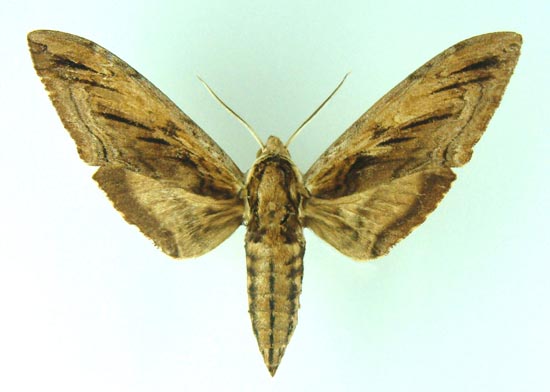
This site has been created by
Bill Oehlke at oehlkew@islandtelecom.com
Comments, suggestions and/or additional information are welcomed by Bill.
TAXONOMY:
Family: Sphingidae, Latreille, 1802
Subfamily: Sphinginae, Latreille, [1802]
Tribe: Sphingini, Latreille, 1802
Genus: Ceratomia Harris, 1839 ...........
Species: amyntor (Geyer, [1835])
|
MIDI MUSIC
.....It's a Wonderful World.....
copyright C. Odenkirk
ON.OFF
<bgsound src="world.mid" LOOP=FOREVER>
|
DISTRIBUTION:
The Elm Sphinx or Four-horned Sphinx,
Ceratomia amyntor,
(Wingspan: 3 1/4 - 4 1/2 inches (8.2 - 11.5 cm)),
flies from Nova Scotia west to Saskatchewan and western North Dakota
and Colorado; south to central Florida, the Gulf Coast, Texas,
and New Mexico and into Mexico. Jim Tuttle now (2009) reports there have been larval and adult sightings in southeastern Arizona.
I have not seen this species on Prince Edward Island, Canada, but my
father has taken females at lights and
reared larvae in Pottersville, New Jersey.
The specimen type locality is Pennsylvania.
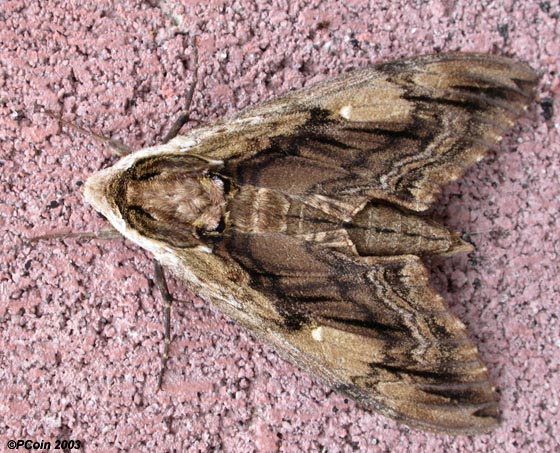
Ceratomia amyntor
© Patrick Coin, used with permission,
Durham County, North Carolina, August 1, 2003
The upperside of the forewing is brown with dark brown and
white markings including a white costal area near the wing base, dark
streaks along the veins, and a white spot in the cell. The upperside
of the hindwing is light brown and has a dark brown band
along the outer margin.
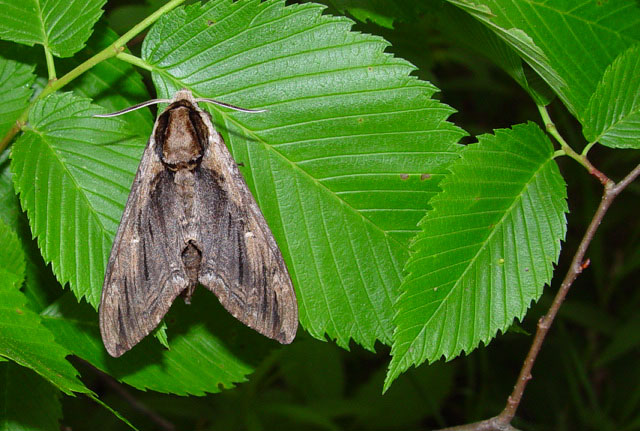
Ceratomia amyntor on elm, June 9, 2005, Peterborough,
Ontario, courtesy of Tim Dyson.
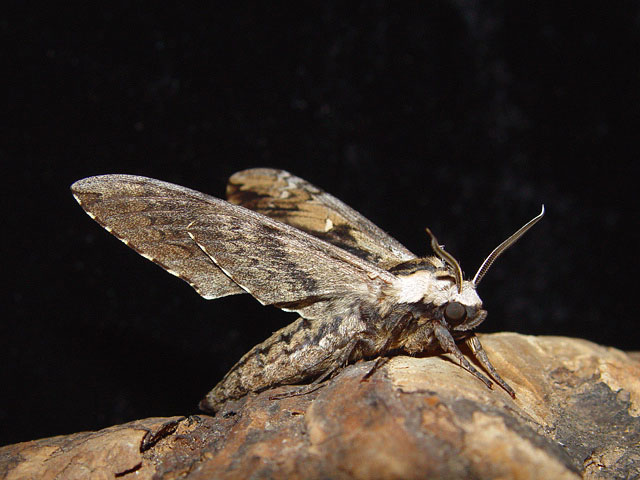
Ceratomia amyntor undersides, Peterborough,
Ontario, courtesy of Tim Dyson.
Visit Ceratomia amyntor, MV light on small building on County Hwy R18, Boone County, Iowa,
June 23, 2009, Thomas Jantscher
Visit Ceratomia amyntor, Waubonsie S.P., Fremont County, Iowa, July 5, 2013; Thomas Jantscher
Visit Ceratomia amyntor, Ogemaw County, Michigan, July 6, 2012, Cindy Mead
Visit Ceratomia amyntor, Liberty, Liberty County, Texas, July 19, 2013, Stuart Marcus
FLIGHT TIMES: Ceratomia amyntor
adults fly as a single brood in a wide variety of forested and open
habitats in the northern portions of their
range from June-July. There are two broods further south, and
Vernon A. Brou confirms five broods in Louisiana from
March-October.
Ceratomia amyntor, Peterborough, Ontario, June 8-9, 2005, courtesy
of Tim Dyson.
ECLOSION:Pupae probably wiggle to surface from
subterranean chambers just prior to eclosion. |
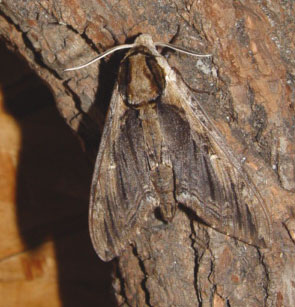 |
SCENTING AND MATING:
Females call in the males with a pheromone released from a gland at the tip of the
abdomen. Adults probably do not feed.
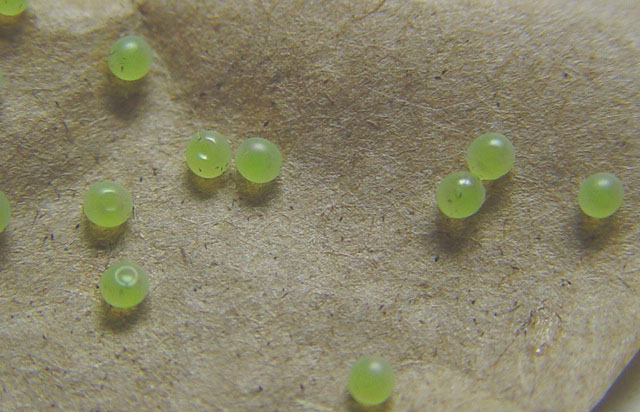
Ceratomia amyntor eggs in brown bag, July 2, 2005, courtesy of Tim Dyson.
EGGS, LARVAE, PUPAE:Females will readily
oviposit translucent, lime green eggs in brown paper sandwich bags.
Tim Dyson has provided this image of a first instar larva on elm,
Peterborough, Ontario, July 5, 2005. |
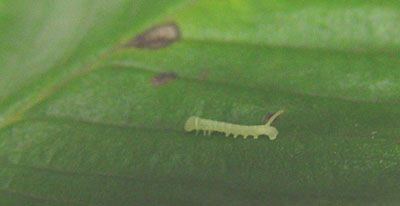 |
Sphingidae rearing is much easier now that we have learned a natural pupation medium is
not necessary. At maturity, larvae will be placed in dark buckets
lined with several layers of paper towels. After a bit of wandering, larvae will crawl
under towelling and
pupate. This first instar larva will probably feed for approximately four-five weeks. |
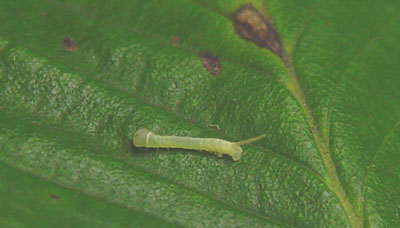 |
Larvae feed on Elm (Ulmus), birch (Betula),
basswood (Tilia), black locust (Robinia pseudoacacia) and cherry (Prunus).There are
chocolate-brown to orangey-brown, sometimes with a pinkish tint,
and green forms of the larvae. The common names
are derived from foodplants (Elm Sphinx) and the structure
(Four-horned Sphinx) of the larva. Green form to right is
courtesy of Tim Dyson.
| 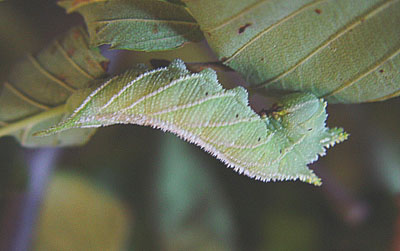 |
Tim Dyson reared a number of these during the
warm 2005 Ontario summer. Larvae moved through five instars in approximately one month.
"Pink" form to right is
courtesy of Tim Dyson. There is often a mix of brown and
green tones on the larvae.
| 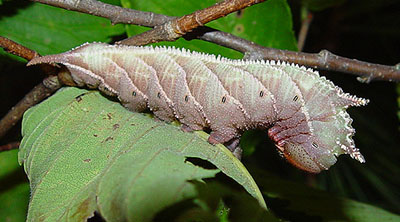 |
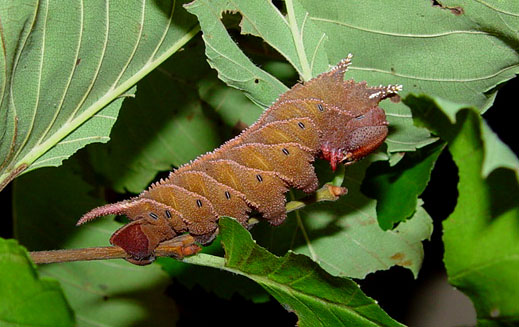
Dark form
courtesy of Tim Dyson.
Visit Ceratomia amyntor larva (green form), Washington County, Rhode Island, August 27, 2009,
Ryan Saint Laurent.
Visit Ceratomia amyntor larva (green form), Norton, New Brunswick, Canada,
September 7, 2009, Gordon Snyder.
Visit Ceratomia amyntor, Saskatoon, Saskatchewan, September 5, 2011, Betty Wotherspoon.
Visit Ceratomia amyntor larva, Keithville, Caddo Parish, Louisiana, September 27, 2007, Jeff Trahan.
Visit Ceratomia amyntor, mature larva, Plateau Mont-Royal, Montreal, September 11, 2013, Mike Guetta.
Fully-grown caterpillars excavate subterranean chambers and pupate
in and overwinter in those underground burrows.
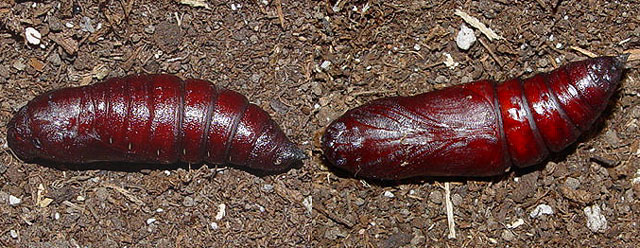
Ceratomia amyntor pupa, courtesy of Tim Dyson.
Many thanks to Ian Miller who has provided sighting
data for many species, including C. amyntor in Eau Claire County, Wisconsin.
Ian writes, "Four-horned sphinx larva bit the webbing of my finger while I tried to move him to another birch cutting and drew blood.
He has some big old jaws on him and very powerful. Won't be picking him up for a while."
The pronunciation of scientific names is
troublesome for many. The "suggestion" at the top of the page is
merely a suggestion. It is based on commonly
accepted English pronunciation of Greek names and/or some
fairly well accepted "rules" for latinized scientific names.
The suggested pronunciations, on this page and on other pages,
are primarily put forward to assist those who hear with internal
ears as they read.
There are many collectors from different countries whose
intonations and accents would be different.
I do not know the origin of the genus choice
Ceratomia, but the first species assigned to this genus
is amyntor. Ceratomia may be a combination of cera (gold)
and tomia (cutting). Speculation suggests the dark cuttings (streaks)
into the golden brown area of the forewing or the golden checkered fringe.
The species name "amyntor" is
from Greek mythology/legend. Amyntor is the king of the Dolopes. He
is killed by Heracles when the king denies Heracles access to his realm.
There would appear to be no descriptive significance for this name choice.
Return to U.S.A. Table
Return to Sphingidae Index
Return to Sphingini Tribe











